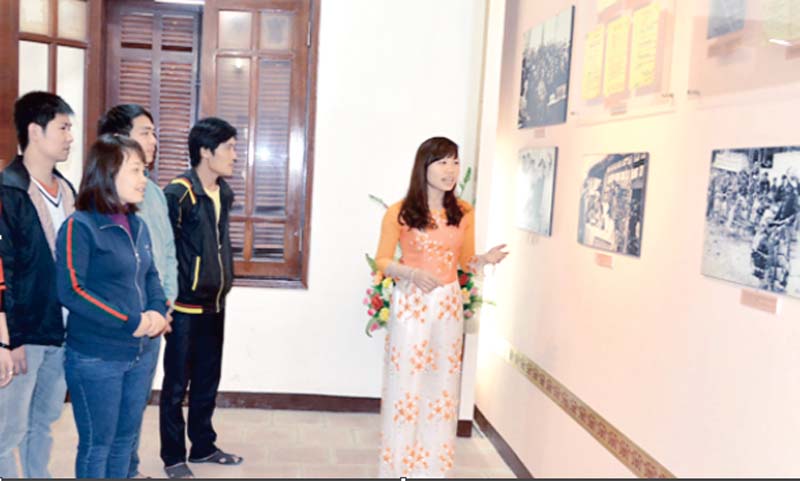
(HBO) – In the whole province, there are 3,120 employees working in the tourism sector, including State management agencies, accommodation establishments, tourist sites and resorts. In recent years, together with investing in material facilities, tourism infrastructure, the task of training and fostering the labor quality in the tourism sector have been paid attention, contributing to promote the tourism industry of the province to develop, attract domestic and foreign tourists to visit and relax.

Tourist Guide of Money Printing Factory
Relics in Co Nghia commune (Lac Thuy)
Currently, the province's tourism sector has
more than 3,100 people, of which 276 people have university degrees or higher,
399 people with intermediate level or college degrees; 1,007 people have primary
level and 1,438 unskilled laborers.
In the province, the model of community-based
tourism has been and is being developed in most localities, mainly in the
districts of Mai Chau, Da Bac, Tan Lac, etc. The characteristics of this model
is that the local people make the tourism business. They are the people who
directly contact with visitors. If they have a good professional level, they
will make good impression and satisfaction to visitors.
At present, the province has 407 tourist
accommodation establishments, including 5 three-star hotels, 18 two-star
hotels, nine 1-star hotels, 233 guest houses and 142 stilt houses. With more
than 2,000 direct laborers in the industry, the task of improving the quality
of laborers is always a matter of concern. Over the past years, the Department
of Culture, Sports and Tourism has opened many professional training courses
for laborers in the field of tourism. In 2017, 9 training courses of tourism
professional skills for 742 trainees were opened. In which, there were 3 classes
for drivers and crews on board to transport tourists with 290 trainees; 3
classes for 300 trainees of staff, specialists in charge of tourism activities
at the Boards of Culture and Communications of the districts, city, commune
cultural staff, owners of business units and households engaged in tourism
activities; 2 training courses on homestay tourism skills for business
households staying in the homestay; 1 class for car drivers and service staff
on passenger transport cars. From the beginning of the year, the department has
opened 5 courses for 354 trainees in management of accommodation, tourism
profession, community tourism and tourism product development.
A diverse chain of eco-tourism and resort destinations concentrated in Hoa Binh city and the districts of Tan Lac, Da Bac, and Luong Son… Along with the launch of several key high-quality resort tourism projects, these developments have reshaped the landscape and enhanced the appeal of Hoa Binh as a travel destination.
Boasting diverse terrain, a mild climate, and rich natural resources, Cao Phong district is increasingly asserting its place on Vietnam’s tourism map, attracting both domestic and foreign visitors. The district is renowned for its stunning landscapes, majestic mountains, a crystal-clear hydropower lake, and the unique cultural identity of local ethnic groups.
With its pristine landscapes, unique cultural heritage of Muong ethnic minority, and an expanding range of visitor experiences, Tan Lac district of Hoa Binh has fast become a captivating destination for both domestic and international tourists.
Until now, Sung village in Cao Son commune, Da Bac district remains the only Dao ethnic community in Hoa Binh province to develop a community-based tourism model. Beyond its untouched natural landscapes, cultural identity serves as the cornerstone attraction for visitors.
Alongside the diverse cultural identities of the Kinh, Muong, Tay, Thai, Dao, and Mong ethnic people, Hoa Binh province is also renowned as the "capital" of the northwestern Vietnamese cuisine, offering unique and distinctive dishes. At festivals, during Lunar New Year (Tet), or on significant family or community occasions, special dishes are prepared, leaving a lasting impression on visitors.
A Phong Linh (Yellow Tabebuia) flower garden in Thang village, Thach Yen commune, Cao Phong district is currently in full bloom, drawing a large number of visitors.



